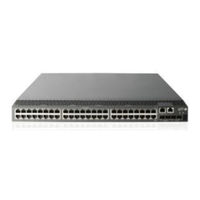HP 5830 series Gigabit Ethernet Switch Manuals
Manuals and User Guides for HP 5830 series Gigabit Ethernet Switch. We have 3 HP 5830 series Gigabit Ethernet Switch manuals available for free PDF download: Configuration Manual, Installation Manual
Advertisement
HP 5830 series Installation Manual (66 pages)
Brand: HP
|
Category: Network Router
|
Size: 5.43 MB
Table of Contents
Advertisement
Advertisement


